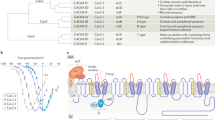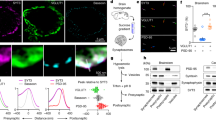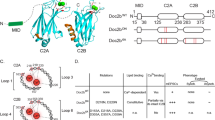Abstract
Little is known about which ion channels determine the resting electrical properties of presynaptic membranes. In recordings made from the rat calyx of Held, a giant mammalian terminal, we found resting potential to be controlled by KCNQ (Kv7) K+ channels, most probably KCNQ5 (Kv7.5) homomers. Unlike most KCNQ channels, which are activated only by depolarizing stimuli, the presynaptic channels began to activate just below the resting potential. As a result, blockers and activators of KCNQ5 depolarized or hyperpolarized nerve terminals, respectively, markedly altering resting conductance. Moreover, the background conductance set by KCNQ5 channels, together with Na+ and hyperpolarization-activated and cyclic nucleotide–gated (HCN) channels, determined the size and time course of the response to subthreshold stimuli. Signaling pathways known to directly affect exocytic machinery also regulated KCNQ5 channels, and increase or decrease of KCNQ5 channel activity controlled release probability through alterations in resting potential. Thus, ion channel determinants of presynaptic resting potential also control synaptic strength.
This is a preview of subscription content, access via your institution
Access options
Subscribe to this journal
Receive 12 print issues and online access
$209.00 per year
only $17.42 per issue
Buy this article
- Purchase on Springer Link
- Instant access to full article PDF
Prices may be subject to local taxes which are calculated during checkout







Similar content being viewed by others
References
Awatramani, G.B., Price, G.D. & Trussell, L.O. Modulation of transmitter release by presynaptic resting potential and background calcium levels. Neuron 48, 109–121 (2005).
Alle, H. & Geiger, J.R. Analog signalling in mammalian cortical axons. Curr. Opin. Neurobiol. 18, 314–320 (2008).
Torborg, C.L., Berg, A.P., Jeffries, B.W., Bayliss, D.A. & McBain, C.J. TASK-like conductances are present within hippocampal CA1 stratum oriens interneuron subpopulations. J. Neurosci. 26, 7362–7367 (2006).
Brown, D.A. & Passmore, G.M. Neural KCNQ (Kv7) channels. Br. J. Pharmacol. 156, 1185–1195 (2009).
Oliver, D., Knipper, M., Derst, C. & Fakler, B. Resting potential and submembrane calcium concentration of inner hair cells in the isolated mouse cochlea are set by KCNQ-type potassium channels. J. Neurosci. 23, 2141–2149 (2003).
Shah, M.M., Migliore, M., Valencia, I., Cooper, E.C. & Brown, D.A. Functional significance of axonal Kv7 channels in hippocampal pyramidal neurons. Proc. Natl. Acad. Sci. USA 105, 7869–7874 (2008).
Forsythe, I.D. Direct patch recording from identified presynaptic terminals mediating glutamatergic EPSCs in the rat CNS, in vitro. J. Physiol. (Lond.) 479, 381–387 (1994).
Dodson, P.D. & Forsythe, I.D. Presynaptic K+ channels: electrifying regulators of synaptic terminal excitability. Trends Neurosci. 27, 210–217 (2004).
Kim, J.H., Sizov, I., Dobretsov, M. & von Gersdorff, H. Presynaptic Ca2+ buffers control the strength of a fast post-tetanic hyperpolarization mediated by the α3 Na+/K+-ATPase. Nat. Neurosci. 10, 196–205 (2007).
Huang, H. & Trussell, L.O. Control of presynaptic function by a persistent Na+ current. Neuron 60, 975–979 (2008).
Ishikawa, T. et al. Distinct roles of Kv1 and Kv3 potassium channels at the calyx of Held presynaptic terminal. J. Neurosci. 23, 10445–10453 (2003).
Taschenberger, H. & von Gersdorff, H. Fine-tuning an auditory synapse for speed and fidelity: developmental changes in presynaptic waveform, EPSC kinetics, and synaptic plasticity. J. Neurosci. 20, 9162–9173 (2000).
Caminos, E., Garcia-Pino, E., Martinez-Galan, J.R. & Juiz, J.M. The potassium channel KCNQ5/Kv7.5 is localized in synaptic endings of auditory brainstem nuclei of the rat. J. Comp. Neurol. 505, 363–378 (2007).
Garcia-Pino, E., Caminos, E. & Juiz, J.M. KCNQ5 reaches synaptic endings in the auditory brainstem at hearing onset and targeting maintenance is activity-dependent. J. Comp. Neurol. 518, 1301–1314 (2010).
Dodson, P.D., Barker, M.C. & Forsythe, I.D. Two heteromeric Kv1 potassium channels differentially regulate action potential firing. J. Neurosci. 22, 6953–6961 (2002).
Song, P. et al. Acoustic environment determines phosphorylation state of the Kv3.1 potassium channel in auditory neurons. Nat. Neurosci. 8, 1335–1342 (2005).
Wang, H.S. et al. KCNQ2 and KCNQ3 potassium channel subunits: molecular correlates of the M-channel. Science 282, 1890–1893 (1998).
Elmedyb, P. et al. Modulation of ERG channels by XE991. Basic Clin. Pharmacol. Toxicol. 100, 316–322 (2007).
Schroeder, B.C., Hechenberger, M., Weinreich, F., Kubisch, C. & Jentsch, T.J. KCNQ5, a novel potassium channel broadly expressed in brain, mediates M-type currents. J. Biol. Chem. 275, 24089–24095 (2000).
Leão, R.N., Tan, H.M. & Fisahn, A. Kv7/KCNQ channels control action potential phasing of pyramidal neurons during hippocampal gamma oscillations in vitro. J. Neurosci. 29, 13353–13364 (2009).
Miceli, F., Cilio, M.R., Taglialatela, M. & Bezanilla, F. Gating currents from neuronal Kv7.4 channels: general features and correlation with the ionic conductance. Channels (Austin) 3, 274–283 (2009).
Tatulian, L., Delmas, P., Abogadie, F.C. & Brown, D.A. Activation of expressed KCNQ potassium currents and native neuronal M-type potassium currents by the anti-convulsant drug retigabine. J. Neurosci. 21, 5535–5545 (2001).
Cooper, E.C., Harrington, E., Jan, Y.N. & Jan, L.Y. M channel KCNQ2 subunits are localized to key sites for control of neuronal network oscillations and synchronization in mouse brain. J. Neurosci. 21, 9529–9540 (2001).
Devaux, J.J., Kleopa, K.A., Cooper, E.C. & Scherer, S.S. KCNQ2 is a nodal K+ channel. J. Neurosci. 24, 1236–1244 (2004).
Kharkovets, T. et al. KCNQ4, a K+ channel mutated in a form of dominant deafness, is expressed in the inner ear and the central auditory pathway. Proc. Natl. Acad. Sci. USA 97, 4333–4338 (2000).
Brueggemann, L.I., Mackie, A.R., Martin, J.L., Cribbs, L.L. & Byron, K.L. Diclofenac distinguishes among homomeric and heteromeric potassium channels composed of KCNQ4 and KCNQ5 subunits. Mol. Pharmacol. 79, 10–23 (2011).
Soh, H. & Tzingounis, A.V. The specific slow afterhyperpolarization inhibitor UCL2077 is a subtype-selective blocker of the epilepsy associated KCNQ channels. Mol. Pharmacol. 78, 1088–1095 (2010).
Goldman, A.M. et al. Arrhythmia in heart and brain: KCNQ1 mutations link epilepsy and sudden unexplained death. Sci. Transl. Med. 1, 2ra6 (2009).
Turecek, R. & Trussell, L.O. Presynaptic glycine receptors enhance transmitter release at a mammalian central synapse. Nature 411, 587–590 (2001).
Turecek, R. & Trussell, L.O. Reciprocal developmental regulation of presynaptic ionotropic receptors. Proc. Natl. Acad. Sci. USA 99, 13884–13889 (2002).
Suh, B.C. & Hille, B. Recovery from muscarinic modulation of M current channels requires phosphatidylinositol 4,5-bisphosphate synthesis. Neuron 35, 507–520 (2002).
Hay, J.C. et al. ATP-dependent inositide phosphorylation required for Ca2+-activated secretion. Nature 374, 173–177 (1995).
Holz, R.W. et al. A pleckstrin homology domain specific for phosphatidylinositol 4,5-bisphosphate (PtdIns-4,5-P2) and fused to green fluorescent protein identifies plasma membrane PtdIns-4,5-P2 as being important in exocytosis. J. Biol. Chem. 275, 17878–17885 (2000).
Micheva, K.D., Holz, R.W. & Smith, S.J. Regulation of presynaptic phosphatidylinositol 4,5-biphosphate by neuronal activity. J. Cell Biol. 154, 355–368 (2001).
Wiedemann, C., Schafer, T. & Burger, M.M. Chromaffin granule-associated phosphatidylinositol 4-kinase activity is required for stimulated secretion. EMBO J. 15, 2094–2101 (1996).
Cochet, C. & Chambaz, E.M. Catalytic properties of a purified phosphatidylinositol-4-phosphate kinase from rat brain. Biochem. J. 237, 25–31 (1986).
Hoshi, N. et al. AKAP150 signaling complex promotes suppression of the M-current by muscarinic agonists. Nat. Neurosci. 6, 564–571 (2003).
Nakajo, K. & Kubo, Y. Protein kinase C shifts the voltage dependence of KCNQ/M channels expressed in Xenopus oocytes. J. Physiol. (Lond.) 569, 59–74 (2005).
Shapiro, M.S. et al. Reconstitution of muscarinic modulation of the KCNQ2/KCNQ3 K+ channels that underlie the neuronal M current. J. Neurosci. 20, 1710–1721 (2000).
Hermann, J., Pecka, M., von Gersdorff, H., Grothe, B. & Klug, A. Synaptic transmission at the calyx of Held under in vivo like activity levels. J. Neurophysiol. 98, 807–820 (2007).
Martire, M. et al. M channels containing KCNQ2 subunits modulate norepinephrine, aspartate, and GABA release from hippocampal nerve terminals. J. Neurosci. 24, 592–597 (2004).
Peretz, A. et al. Pre- and postsynaptic activation of M-channels by a novel opener dampens neuronal firing and transmitter release. J. Neurophysiol. 97, 283–295 (2007).
Vervaeke, K., Gu, N., Agdestein, C., Hu, H. & Storm, J.F. Kv7/KCNQ/M-channels in rat glutamatergic hippocampal axons and their role in regulation of excitability and transmitter release. J. Physiol. (Lond.) 576, 235–256 (2006).
Lerche, C. et al. Molecular cloning and functional expression of KCNQ5, a potassium channel subunit that may contribute to neuronal M-current diversity. J. Biol. Chem. 275, 22395–22400 (2000).
Xu, T. et al. Roles of alternative splicing in the functional properties of inner ear-specific KCNQ4 channels. J. Biol. Chem. 282, 23899–23909 (2007).
Roura-Ferrer, M. et al. Functional implications of KCNE subunit expression for the Kv7.5 (KCNQ5) channel. Cell. Physiol. Biochem. 24, 325–334 (2009).
Chambard, J.M. & Ashmore, J.F. Regulation of the voltage-gated potassium channel KCNQ4 in the auditory pathway. Pflugers Arch. 450, 34–44 (2005).
Saitoh, N., Hori, T. & Takahashi, T. Activation of the epsilon isoform of protein kinase C in the mammalian nerve terminal. Proc. Natl. Acad. Sci. USA 98, 14017–14021 (2001).
Rhee, J.S. et al. Beta phorbol ester- and diacylglycerol-induced augmentation of transmitter release is mediated by Munc13s and not by PKCs. Cell 108, 121–133 (2002).
Trussell, L.O. Synaptic mechanisms for coding timing in auditory neurons. Annu. Rev. Physiol. 61, 477–496 (1999).
Acknowledgements
We thank V. Balakrishnan and P. Brehm for comments, K. Bender and S. Kuo for technical advice and B. Kachar (National Institute on Deafness and Other Communication Disorders) for KCNQ4 antibody. L.O.T. is supported by US National Institutes of Health grants DC004450 and NS028901.
Author information
Authors and Affiliations
Contributions
H.H. conducted and analyzed all experiments. H.H. and L.O.T. designed experiments and wrote the manuscript.
Corresponding author
Ethics declarations
Competing interests
The authors declare no competing financial interests.
Supplementary information
Supplementary Text and Figures
Supplementary Figures 1–6 (PDF 408 kb)
Rights and permissions
About this article
Cite this article
Huang, H., Trussell, L. KCNQ5 channels control resting properties and release probability of a synapse. Nat Neurosci 14, 840–847 (2011). https://doi.org/10.1038/nn.2830
Received:
Accepted:
Published:
Issue Date:
DOI: https://doi.org/10.1038/nn.2830
This article is cited by
-
Mechanisms and clinical implications of intervertebral disc calcification
Nature Reviews Rheumatology (2022)
-
The subthreshold-active KV7 current regulates neurotransmission by limiting spike-induced Ca2+ influx in hippocampal mossy fiber synaptic terminals
Communications Biology (2019)
-
Modulation of Kv7 channels and excitability in the brain
Cellular and Molecular Life Sciences (2017)
-
KCNQ potassium channels in sensory system and neural circuits
Acta Pharmacologica Sinica (2016)
-
KCNQ5 K+ channels control hippocampal synaptic inhibition and fast network oscillations
Nature Communications (2015)



